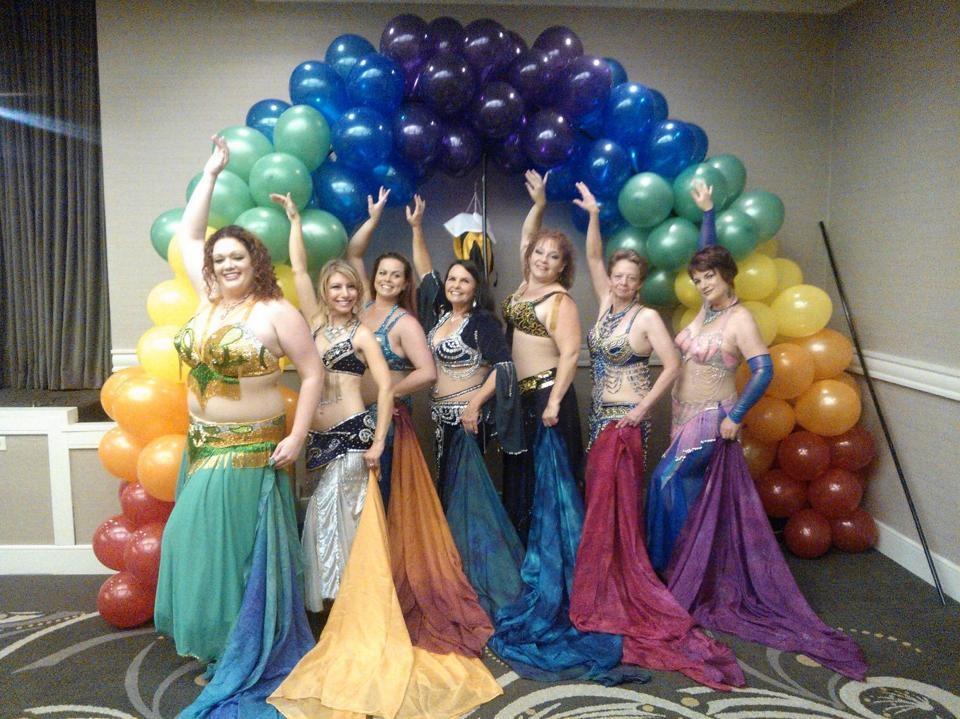Bellyography – June 2005
Community
Zuhra Zakiyah
The first time I watched Zuhra Zakiyah dance, I was at the Athenian in Ogden. Performing to a Hossam Ramzy piece of music, I was immediately impressed by her heartfelt interpretation of the music and her commitment to the art form—a commitment to professionalism and authenticity. She possesses a grace and delight in the dance that can only come with knowledge and intelligence. A beautiful dancer, she is also a beautiful person. When Nikia of Whispering Sands became ill last year, Zuhra took over and kept her classes going and performing. Like I said, a beautiful person and obviously, a great friend.
[Zuhra Zakiyah] Zuhra Zakiyah, which means “Woman of Sharp Wit” in Arabic, moved to the Wasatch Front from San Francisco in 1983 to start her own business and raise a family. Six years ago, she began studying raks sharqi with Moshara Rabia, and most recently, with Nikia and Aja. Today, Zuhar Zakiyah is the assistant director of the Whispering Sands Dance Company.
Zuhra Zakiyah resonates best with the ethnic folkloric style of Middle Eastern dance, but she also loves Egyptian Cabaret. Hadia and Morocco are her favorite dancers, each epitomizing her favorite styles of dancing. She has taken workshops with both and is a self-proclaimed “workshop addict.”
“In a three-day workshop in Canada, Hadia taught us all of the instruments used in Middle Eastern music and how to interpret them. Each instrument requires a specific type of movement. Our bodies are instruments of the music through the dancing. I now really hear what the instruments are telling the dancer to do; for instance, the quanoon requires a light shimmy, and the nay flute is very floaty and up.”
“What I love about Middle Eastern dance is that there is so much information available and you can learn so much about the varied cultures, history, regions and dances. It is like the music—multilayered. The more you learn, the more you discover that you don’t know. It is the perfect never-ending hobby. There is always more to research and learn.”
“I spent the millennium eve in Egypt and fell in love with the culture. How Egyptians regard belly dancing is very different than in the United States. I believe Americans have taken belly dancing, or raks sharqi, and elevated it into the art form it is and deserves to be. It takes great determination to learn Middle Eastern dance.”
“Utah is a great place. Our belly dance community is so special and so big compared to other cities. Our dancers are being recognized nationally, and we have many opportunities available to us. The bar has been raised in Utah. Our quality, experience and knowledge of Middle Eastern dance have truly increased in the past few years. I love it!”Zuhra Zakiyah, which means “Woman of Sharp Wit” in Arabic, moved to the Wasatch Front from San Francisco in 1983 to start her own business and raise a family. Six years ago, she began studying raks sharqi with Moshara Rabia, and most recently, with Nikia and Aja. Today, Zuhar Zakiyah is the assistant director of the Whispering Sands Dance Company.
Zuhra Zakiyah resonates best with the ethnic folkloric style of Middle Eastern dance, but she also loves Egyptian Cabaret. Hadia and Morocco are her favorite dancers, each epitomizing her favorite styles of dancing. She has taken workshops with both and is a self-proclaimed “workshop addict.”
“In a three-day workshop in Canada, Hadia taught us all of the instruments used in Middle Eastern music and how to interpret them. Each instrument requires a specific type of movement. Our bodies are instruments of the music through the dancing. I now really hear what the instruments are telling the dancer to do; for instance, the quanoon requires a light shimmy, and the nay flute is very floaty and up.”
“What I love about Middle Eastern dance is that there is so much information available and you can learn so much about the varied cultures, history, regions and dances. It is like the music—multilayered. The more you learn, the more you discover that you don’t know. It is the perfect never-ending hobby. There is always more to research and learn.”
“I spent the millennium eve in Egypt and fell in love with the culture. How Egyptians regard belly dancing is very different than in the United States. I believe Americans have taken belly dancing, or raks sharqi, and elevated it into the art form it is and deserves to be. It takes great determination to learn Middle Eastern dance.”
“Utah is a great place. Our belly dance community is so special and so big compared to other cities. Our dancers are being recognized nationally, and we have many opportunities available to us. The bar has been raised in Utah. Our quality, experience and knowledge of Middle Eastern dance have truly increased in the past few years. I love it!”
Zuhra Zakiyah will perform with the Whispering Sands Dance Company at Thia’s Virginia Show June 11 and solo and troupe performances at the Utah Belly Dance Festival in August. She also performs regularly at Ogden’s Athenian Restaurant.
